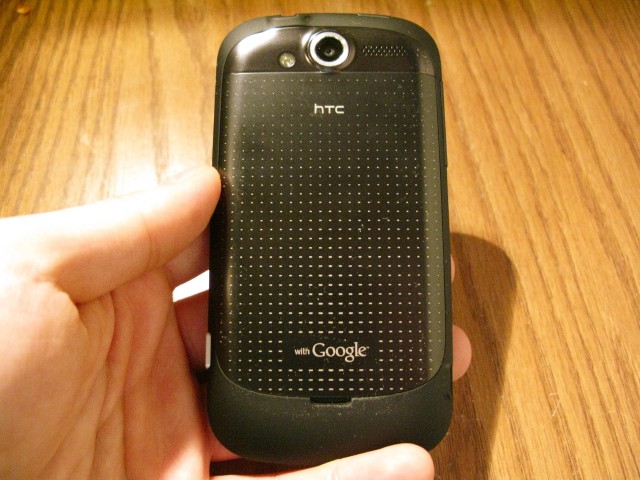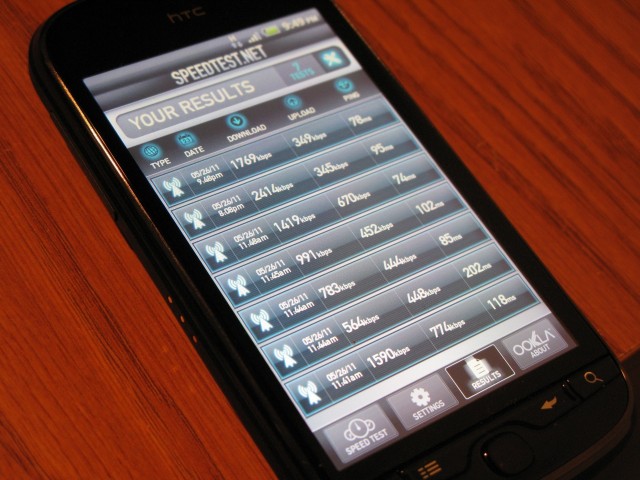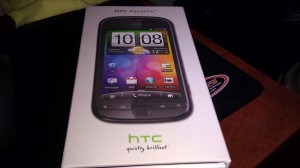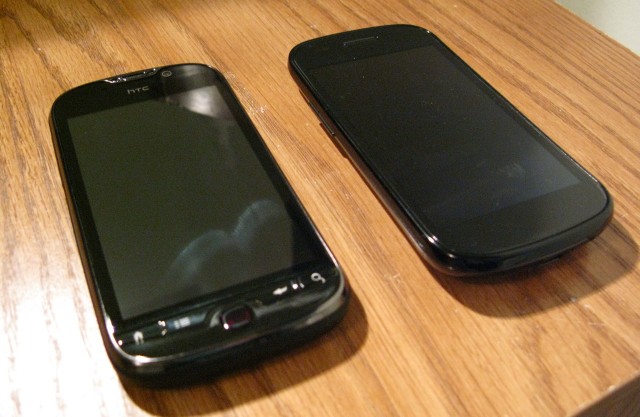The HTC Panache doesn’t try to be anything it’s not. It is aware of the fact that it’s a re-tooled Glacier, the device that would, in October 2010, become T-Mobile’s myTouch 4G. In fact, Mobilicity has taken a great many cues from T-Mobile since its launch, and for good reason: both companies are fighting their way up in a very competitive, saturated market.
The re-tooling has been kind to the Panache. Equipped with still-marketable internal specs and a shiny Gingerbread makeover, it packs quite a punch for the discount carrier, and slots in next to the Nexus S at the same $499 price point. Does the Panache have the right amount of… itself? Read on.
Specs:
– Android 2.3 Gingerbread with HTC Sense 2.1 UI
– 3.8” 480×800 TFT LCD display
– 1Ghz Qualcomm MSM8255 Snapdragon processor
– 768MB RAM / 1.1GB internal storage / 8GB microSD card provided
– 5MP camera with LED flash / VGA front-facing camera
– 720p-capable video recording
– WiFi / GPS / Bluetooth
– 1400mAh battery
– 121.9 x 55.9 x 10.9 mm
– 141.8 g
The Phone
Panache. It sounds like a fruit drink. In the case of a smartphone, it should represent the attractive frame that holds the secrets to Android paradise. In many ways, the Panache was one of our favourite phones to hold, and it was easy to slip in and out of the pocket.
Made of a charcoal-coloured hard matte plastic, the front and sides of the device taper in a geometrically pleasing way. It resembles the BlackBerry Bold Touch in some ways, and because it is so thin its heft does not feel onerous. The battery cover is made of a nice chunk of brushed aluminum, and since the phone tops out at 142g, only slightly heavier than the Nexus S, the extra weight, in exchange for solidity, was more than welcome.
But its front also gives away its aging pedigree: equipped with a rather cutesy speaker grill and four hardware buttons on the bottom, as well as a trackpad, the phone screams 2010 Android. None of these inclusions are bad, per se, but like certain fashion they seem out of date. Admittedly, it was satisfying feeling some physical feedback from the buttons, and even with the newest version of Sense and its excellent text selection the trackpad came in handy.
Another pleasant surprise, and a trend we wish more manufacturers would bring back, was the dedicated camera button on the lower right side. Metallic and clicky, the camera button was perfectly weighted. Once unlocked, holding down the button will launch the camera app, though not fast enough for our liking.
Performance & Call Quality
Sense UI has always been the athletic, attractive sibling of Android skins, and the small-but-significant upgrade to Gingerbread brings some zest to the Panache’s aging hardware.
Once logged into your Google account, you’ll be greeted with seven home screens, each of which is loaded with a removable widget. To some a blessing and others a scourge, the widgets offer quick access to weather, social networks, email, messages and maps. Sense has been given a nice aesthetic overhaul, too: the drop-down notification bar now shows the most-recently used apps, and on the bottom is quick settings tab, to quickly disable WiFi or enable GPS, among other things.
The phone took what we threw at it without complaint, and averaged a healthy 1576 on the Quadrant Benchmark test, right in line with the similarly-spec’d HTC Desire HD and Incredible S. Linpack scored a whopping 39.6 from the single-core processor. It reached 2.4Mbit/s download speeds with Speedtest, though the average was around 1.3Mbit/s down and 450kbit/s up, which is about what one can expect from Mobilicity’s growing network.
Overall, network speeds really slowed down the phone. Once a webpage loaded it handled flawlessly, but we were often waiting several minutes for the desktop version of NYTimes.com to load, our typical bandwidth-choking benchmark. Mobilicity has a long way to go before it will reach those 4G speeds the Big Three are advertising.
Call quality within the GTA was top-notch. Even with 1-2 bars we couldn’t drop a call, and they came through nice and clearly. Despite claims from critics and certain comment trolls, we have yet to encounter issues with Mobilicity’s reception, except indoors where other AWS carriers such as Wind Mobile equally suffer. There are some areas in the GTA where Mobilicity’s coverage is still lacking, and certain nooks without any at all, but since its launch over a year ago that number has diminished significantly.
The Panache does have some very cool call features. If you receive a call you’d like to mute, you can flip the device onto its face. If the proximity sensor detects the phone is in a pocket, it will increase the ringer volume. Similarly, when you pick it up to answer the call, the volume lowers slightly. Intuitive and helpful features from HTC, especially for those who still use their smartphones as phones.
For a more in-depth look at Sense 2.1, take a look at our HTC Incredible S review.
Camera
The Panache’s camera takes some nice photos in good lighting, but like most HTC lenses, it struggles with low-light situations. Grain is introduced at medium ISO settings, so the lens clearly isn’t letting in enough light. Software processing leaves photos a little softer than we’d like but otherwise unharmed. Shooting with the flash was hit and miss. Sometimes the scene would be lighted perfectly, and at other times the flash would completely overwhelm.
HTC’s camera interface is a blessing, and something we wish Google itself would crib from. It supports touch-to-focus, even while shooting 720p video, and there are custom ISO, exposure, saturation and contrast settings for you tweakers out there. Because the camera is weighted so evenly, we found holding it in one hand a non-issue, and with the dedicated button, it became our shooter of choice for the time we had it.
HD video gets off similarly well. Little to no artifacting or distortion and crisp colours make for a decent point-and-shoot replacement, though like any small-lensed device the final product always had a little too much shakiness, regardless of how rigidly we held on.
The addition of a front-facing camera is welcome, but since HTC kept the device at Android version 2.3.3 and not the GTalk Video-supported 2.3.4, we were unable to test out native video chat. Apps like Fring, Tango and Qik work just fine, especially over WiFi, but if you’re trying to show your friends that new wrinkle that just popped up, you’re out of luck; faces are just a blurry mash.
Click to enlarge pictures to full 5MP resolution.
Battery Life
Like most HTC devices running Snapdragon processors, the Panache is kind to its users. The 1400mAh battery ran for over 16 hours of regular use before hitting the red, and that included regular background updates, browsing, phone calls and photos.
HD video seemed to be the most abusive on battery life, knocking around 5% for every 10 minutes shot, but overall gaming, browsing and tweeting won’t force you to charge every 4 hours like many other Android devices.
Quirks and Quarks
As much as we liked the Panache, there were a couple trouble spots. Firstly, the screen seems to be the same washed-out TFT display as on the myTouch 4G. It was discovered after a couple months release that HTC was sourcing LCD displays from two manufacturers: one located in Taiwan, the other in China. The ones from Taiwan had terrible colour saturation and narrow viewing angles, while the Chinese-sourced ones were much more like the Super LCD displays that shipped on later HTC devices: excellent viewing angles, deep blacks and accurate colours. Both screens use the same touch sensor, which is very accurate, so no concern there.
Our review unit had the poor display, but it is not known whether all units will ship with the same part. Whether Mobilicity acknowledges this as a defect and will allow returns remains to be seen.
The other main gripe we had with the Panache was price. For $499, one expects the best, a flagship device that brings the carrier brand forward. If this is the best Mobilicity can do – rebranding an eight month-old phone and calling it new – they have a lot of work to do on their device acquisition. But they are a small carrier on an even narrower GSM network, and until manufacturers begin releasing pentaband 3G devices in volume, AWS carriers like Mobilicity, Wind and even T-Mobile will always have less buying power than their AT&T/Rogers counterparts.
The End
We haven’t really talked about the benefits of owning a smartphone on Mobilicity, and that too is price. While you’re paying $499 upfront for the device, the amount saved year over year for service is truly quantifiable. Mobilicity offers an all-in $45 unlimited province-wide calling plus data plan, and for $10 more you can include Canadian and U.S. long distance, and global texting. We would be remiss not to point out that despite the limited service area (GTA, Ottawa, Calgary, Edmonton and Vancouver) Mobilicity offers some of the lowest price comprehensive plans in Canada. And regardless of where you stand in the rivalry between Wind Mobile and Mobilicity, for city dwellers they really are becoming viable alternatives to the Big Three.
The HTC Panache is still, eight months later, a very good smartphone. As a phone it performs admirably; as an Android device it possess up-to-date software on slightly dated hardware, but not enough to call it old. While we can recommend it to fans of Sense, and of Android in general, it’s a hard call to make over the identically-priced and similarly-spec’d Nexus S, still our smartphone of choice. A little bit smoother, a little bit prettier but not nearly as ‘open’, the Panache will age faster than its Nexus counterpart. So if you’re going to get it, get it now.
Rating: 7/10
Pros:
– Excellent, stable performance on Gingerbread
– Nice build quality: love the aluminum battery cover
– Dedicated camera button: great two-step feedback
– Good still and video quality: HD video is smooth
– Sense UI provides some excellent additions to Android’s feature roster
– Decent battery life: lasts all day
– Great call quality in high reception areas
Cons:
– Price: it’s too high for the hardware specs
– Inferior screen quality to similar devices: weak colour saturation, viewing angles
– Questionable design choices: superfluous trackpad and ugly speaker grill
– Some areas still don’t get Mobilicity service
– Could be heavy for some users










